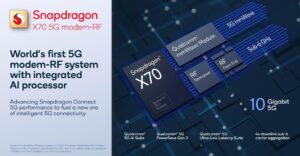Qualcomm Technologies has announced the Snapdragon X70 5G Modem-RF System, its 5th generation modem-to-antenna 5G solution. Snapdragon X70 introduces the world’s first 5G AI processor in a modem-RF system, to harness the power of AI for breakthrough 5G performance with 10 Gigabit 5G downloads — offering fast upload speeds, low latency, coverage, and power efficiency.
The capabilities of Snapdragon X70 offer flexibility to global 5G operators to maximize spectrum resources for the best possible 5G connectivity.
 The Qualcomm 5G AI Suite is designed for AI-powered optimizations of sub-6 GHz and mmWave 5G links for improved speeds, coverage, latency, mobility, and power efficiency to fuel the Connected Intelligent Edge.
The Qualcomm 5G AI Suite is designed for AI-powered optimizations of sub-6 GHz and mmWave 5G links for improved speeds, coverage, latency, mobility, and power efficiency to fuel the Connected Intelligent Edge.
The Qualcomm 5G AI Suite lays the foundation for next-generation 5G performance enhancements, including:
- AI-based channel-state feedback and dynamic optimization
- World’s first AI-based mmWave beam management for superior mobility and coverage robustness
- AI-based network selection for superior mobility and link robustness
- AI-based adaptive antenna tuning for up to 30 percent improved context detection for higher average speeds and coverage
Built on the global success of Snapdragon X65, X60, X55, and X50 solutions, Snapdragon X70 offers ultimate flexibility for global operators to maximize spectrum resources for deploying the best possible 5G connectivity for consumers, enterprises, and the Connected Intelligent Edge.
Snapdragon X70 features:
- World’s only comprehensive 5G modem-RF system family capable of supporting every commercial 5G band from 600 MHz to 41 GHz, offering flexibility to OEMs for designing devices capable of supporting global operator requirements
- Unmatched global band support and spectrum aggregation capabilities, including world’s first 4X downlink carrier aggregation across TDD and FDD, mmWave-sub-6 aggregation
- Standalone mmWave support to allow MNOs and service providers to deploy services such as fixed wireless access and enterprise 5G, without needing sub-6 GHz spectrum
- Unmatched uplink performance and flexibility with uplink carrier aggregation and switched uplink support across TDD and FDD
- True global 5G multi-SIM including Dual-SIM Dual-Active (DSDA) and mmWave support
- Upgradeable architecture allowing rapid commercialization of 5G Release 16 features through software updates
Snapdragon X70 inherits the unrivaled 10 Gigabit 5G peak download speed of its predecessor and packs in new, advanced capabilities such as Qualcomm 5G AI Suite, Qualcomm 5G Ultra-Low Latency Suite, and 4X carrier aggregation to achieve unmatched 5G speeds, coverage, signal quality and low latency.
The Qualcomm 5G Ultra-Low Latency Suite in Snapdragon X70 allows OEMs and operators to minimize latency for hyper-responsive 5G user experiences and applications.
“Our 5th generation modem-RF system extends our global 5G leadership and the introduction of native 5G AI processing creates a platform and inflection point for performance-enhancing innovations,” said Durga Malladi, senior VP and GM, 5G, Mobile Broadband and Infrastructure, Qualcomm Technologies. “Snapdragon X70 is an example of how we’re realizing the full potential of 5G and making an intelligently connected world possible.”
Snapdragon X70 introduces new Qualcomm 5G PowerSave Gen 3, coupled with a 4nm baseband process, and advanced modem-RF technologies such as Qualcomm QET7100 Wideband Envelope Tracking and AI-based adaptive antenna tuning that dynamically optimize transmit and receive paths across a comprehensive set of user scenarios and signal conditions to significantly reduce power consumption and extend battery life.
Powered by the mobile industry’s most expansive feature set, Snapdragon X70 helps achieve superior 5G performance on more networks globally. Its fiber-like browsing speeds and latency, delivered wirelessly over 5G, pave the way for the next generation of connected applications and experiences.
Devices designed with all key capabilities of the Snapdragon X70 along with best-in-class Qualcomm® FastConnect™ Wi-Fi/Bluetooth systems conform with the new ‘Snapdragon Connect’ badge — which highlights the use of the best connectivity technologies available in Snapdragon Platforms.
Filed Under: 5G, Components, News


Questions related to this article?
👉Ask and discuss on Electro-Tech-Online.com and EDAboard.com forums.
Tell Us What You Think!!
You must be logged in to post a comment.